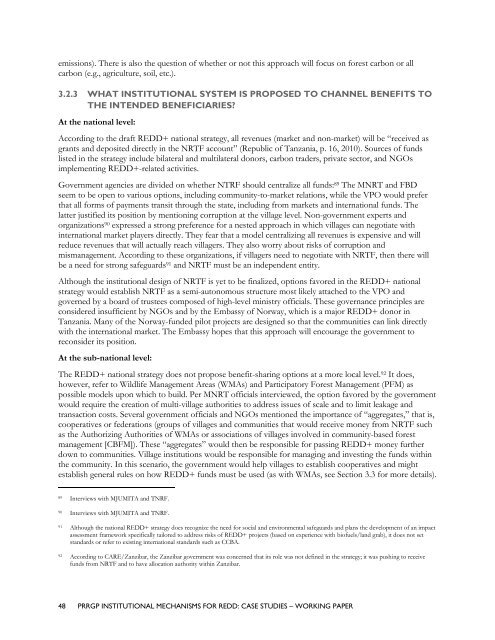Institutional Mechanisms for REDD+ - Case Studies Working Paper
Institutional Mechanisms for REDD+ - Case Studies Working Paper
Institutional Mechanisms for REDD+ - Case Studies Working Paper
Create successful ePaper yourself
Turn your PDF publications into a flip-book with our unique Google optimized e-Paper software.
emissions). There is also the question of whether or not this approach will focus on <strong>for</strong>est carbon or all<br />
carbon (e.g., agriculture, soil, etc.).<br />
3.2.3 WHAT INSTITUTIONAL SYSTEM IS PROPOSED TO CHANNEL BENEFITS TO<br />
THE INTENDED BENEFICIARIES?<br />
At the national level:<br />
According to the draft <strong>REDD+</strong> national strategy, all revenues (market and non-market) will be ―received as<br />
grants and deposited directly in the NRTF account‖ (Republic of Tanzania, p. 16, 2010). Sources of funds<br />
listed in the strategy include bilateral and multilateral donors, carbon traders, private sector, and NGOs<br />
implementing <strong>REDD+</strong>-related activities.<br />
Government agencies are divided on whether NTRF should centralize all funds: 89 The MNRT and FBD<br />
seem to be open to various options, including community-to-market relations, while the VPO would prefer<br />
that all <strong>for</strong>ms of payments transit through the state, including from markets and international funds. The<br />
latter justified its position by mentioning corruption at the village level. Non-government experts and<br />
organizations 90 expressed a strong preference <strong>for</strong> a nested approach in which villages can negotiate with<br />
international market players directly. They fear that a model centralizing all revenues is expensive and will<br />
reduce revenues that will actually reach villagers. They also worry about risks of corruption and<br />
mismanagement. According to these organizations, if villagers need to negotiate with NRTF, then there will<br />
be a need <strong>for</strong> strong safeguards 91 and NRTF must be an independent entity.<br />
Although the institutional design of NRTF is yet to be finalized, options favored in the <strong>REDD+</strong> national<br />
strategy would establish NRTF as a semi-autonomous structure most likely attached to the VPO and<br />
governed by a board of trustees composed of high-level ministry officials. These governance principles are<br />
considered insufficient by NGOs and by the Embassy of Norway, which is a major <strong>REDD+</strong> donor in<br />
Tanzania. Many of the Norway-funded pilot projects are designed so that the communities can link directly<br />
with the international market. The Embassy hopes that this approach will encourage the government to<br />
reconsider its position.<br />
At the sub-national level:<br />
The <strong>REDD+</strong> national strategy does not propose benefit-sharing options at a more local level. 92 It does,<br />
however, refer to Wildlife Management Areas (WMAs) and Participatory Forest Management (PFM) as<br />
possible models upon which to build. Per MNRT officials interviewed, the option favored by the government<br />
would require the creation of multi-village authorities to address issues of scale and to limit leakage and<br />
transaction costs. Several government officials and NGOs mentioned the importance of ―aggregates,‖ that is,<br />
cooperatives or federations (groups of villages and communities that would receive money from NRTF such<br />
as the Authorizing Authorities of WMAs or associations of villages involved in community-based <strong>for</strong>est<br />
management [CBFM]). These ―aggregates‖ would then be responsible <strong>for</strong> passing <strong>REDD+</strong> money further<br />
down to communities. Village institutions would be responsible <strong>for</strong> managing and investing the funds within<br />
the community. In this scenario, the government would help villages to establish cooperatives and might<br />
establish general rules on how <strong>REDD+</strong> funds must be used (as with WMAs, see Section 3.3 <strong>for</strong> more details).<br />
89 Interviews with MJUMITA and TNRF.<br />
90 Interviews with MJUMITA and TNRF.<br />
91 Although the national <strong>REDD+</strong> strategy does recognize the need <strong>for</strong> social and environmental safeguards and plans the development of an impact<br />
assessment framework specifically tailored to address risks of <strong>REDD+</strong> projects (based on experience with biofuels/land grab), it does not set<br />
standards or refer to existing international standards such as CCBA.<br />
92 According to CARE/Zanzibar, the Zanzibar government was concerned that its role was not defined in the strategy; it was pushing to receive<br />
funds from NRTF and to have allocation authority within Zanzibar.<br />
48 PRRGP INSTITUTIONAL MECHANISMS FOR REDD: CASE STUDIES – WORKING PAPER

















